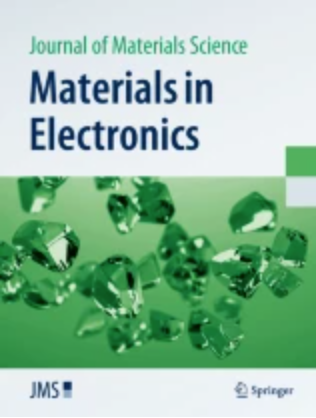Effect of the ZnO addition on the sinterability and microwave dielectric properties of BPO4
IF 2.8
4区 工程技术
Q2 ENGINEERING, ELECTRICAL & ELECTRONIC
Journal of Materials Science: Materials in Electronics
Pub Date : 2025-05-22
DOI:10.1007/s10854-025-14925-6
引用次数: 0
Abstract
BPO4 has low εr (< 5) and an acceptable high Q × f value, while extremely poor sinterability. It showed that, in the present work, an appropriate addition of ZnO could simultaneously enhance the sinterability and microwave dielectric properties of BPO4 ceramic. The addition of ZnO led to the formation of zinc-phosphates, a small amount of zinc borate, and B2O3 secondary phases, which increased with increasing the ZnO addition. A small amount of ZnO addition increased the dielectric permittivity, Q × f value, and more negative τf value. The 0.97BPO4-0.07ZnOceramic exhibit good combined microwave dielectric properties with εr ~ 4.75, Q × f ~ 55,000 GHz, and τf ~ -42 ppm/℃after sintering at 1150 °C/2 h.
ZnO对BPO4烧结性能和微波介电性能的影响
BPO4具有较低的εr (< 5)和可接受的高Q × f值,但烧结性极差。结果表明,在本工作中,适当添加ZnO可以同时提高BPO4陶瓷的烧结性能和微波介电性能。ZnO的加入导致磷酸锌、少量硼酸锌和B2O3次生相的形成,并随着ZnO添加量的增加而增加。少量ZnO的加入增加了介质介电常数、Q × f值,并增加了负τf值。在1150℃/2 h烧结后,0.97 bpo4 -0.07 zno陶瓷表现出良好的复合微波介电性能,εr ~ 4.75, Q × f ~ 55,000 GHz, τf ~ -42 ppm/℃。
本文章由计算机程序翻译,如有差异,请以英文原文为准。
求助全文
约1分钟内获得全文
求助全文
来源期刊
CiteScore
5.00
自引率
7.10%
发文量
1931
审稿时长
2 months
期刊介绍:
The Journal of Materials Science: Materials in Electronics is an established refereed companion to the Journal of Materials Science. It publishes papers on materials and their applications in modern electronics, covering the ground between fundamental science, such as semiconductor physics, and work concerned specifically with applications. It explores the growth and preparation of new materials, as well as their processing, fabrication, bonding and encapsulation, together with the reliability, failure analysis, quality assurance and characterization related to the whole range of applications in electronics. The Journal presents papers in newly developing fields such as low dimensional structures and devices, optoelectronics including III-V compounds, glasses and linear/non-linear crystal materials and lasers, high Tc superconductors, conducting polymers, thick film materials and new contact technologies, as well as the established electronics device and circuit materials.

 求助内容:
求助内容: 应助结果提醒方式:
应助结果提醒方式:


